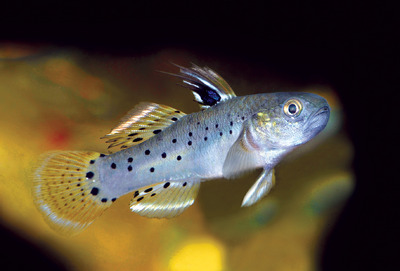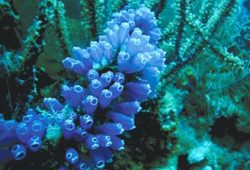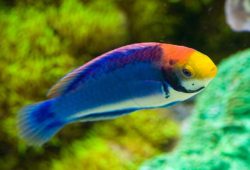A fishkeeper’s guide to gobies
This article tells you about A fishkeeper’s guide to gobies. If ever the word “character” can be applied to any fish, the goby is it. They are a fascinating group of bottom-dwelling fish that exhibit a range of quirky and interesting behaviours. And there are loads of them about – the suborder Gobioidei contains more than 2000 species in eight families.

The majority of species belong to two of these families: the Gobiidae, true gobies, with over 1850 species, and the Eleotridae, sleeper gobies, with around 150 species. Yet despite this sheer number (gobies represent 8-9% of all known fish species), few species are kept in aquaria.
True gobies all share certain features. These include a sucking disc formed by the pelvic fins (the sleeper gobies lack this), two dorsal fins, and a relatively small size. Most species are less than 10cm/4″ in length. Indeed, the smallest fish in the world belongs to this group – the Stout infantfish, Schindleria brevipinguis, is mature at 8.4mm!
Most gobies are marine fishes, but a number are found in brackish and freshwater environments. Many have evolved to exploit very specialised niches. Perhaps one of the best known examples of this is the mudskipper, which can leave the water to feed on terrestrial insects.
It is difficult to generalise too much about the care of gobies in the aquarium since the commonly available species of gobies and sleepers vary somewhat in their requirements and compatibility. The species covered here demonstrate the diversity of these fishes.
Contents
Knight goby
The Knight goby, Stigmatogobius sadanundio, is a commonly available species from Asia and found in both fresh and brackish waters. They will fare best in aquaria if kept in lightly brackish water. If kept in freshwater, it should be hard and alkaline.
Knight gobies have an attractive, black-spotted pattern and colourful finnage, and grow to a maximum of just over 7.5cm/3″. They are territorial, although a group can be kept together in a spacious tank with plenty of decor. Provide plenty of caves for retreats.
Plants which grow well in hard and alkaline water, or tolerate lightly brackish conditions, can also be used. They can generally be mixed with other similarly-sized fishes without problems, but avoid too many bottom-dwellers.
They are fairly omnivorous and should be fed a varied diet including frozen and live foods; they will also eat some algae.
A temperature of 21-26C/70-79F should be suitable, maintaining it nearer the higher end for breeding purposes. Males can be recognised by their longer anal and second dorsal fins, and by extended fin rays on the first dorsal fin. Females have a more yellowish colour.
Following much displaying and chasing, several hundred eggs are normally laid in caves and guarded by the male.
Bumblebee goby
The common name of Bumblebee goby refers to a number of similar species from the Hypogymnogobius genus (formerly Brachygobius), which are easily recognised by their small, squat bodies and black and yellow stripes. These include H. doriae, xanthozonus and nunus.
All of these species remain small, at less than 5cm/2″, and require similar care. They originate from various parts of Asia, where they are mainly found in brackish water.
It is recommended that they are maintained in at least lightly brackish conditions (specific gravity 1.005) in the aquarium for their long-term health. They are best kept as a group, with plenty of small stones and pieces of wood to provide lots of refuges. Ideally, they should be kept in a small species aquarium. One of the main reasons for this is to make feeding this small, secretive, bottom-feeder easier.
A variety of frozen and live foods should be provided; they usually show little interest in dry foods. If you wish to add fish to make use of the upper levels of the tank, then glassfish (Parambassis species; but not the artificially dyed variety!) or Mollies would be appropriate choices, which should thrive in slightly brackish water.
Breeding may be induced by adding slightly cooler fresh water. Pairs will normally form from the group, and territorial behaviour will become more pronounced. The female will lay eggs in a small cave or beneath a stone, possibly numbering up to 200. They are guarded by the male, who will also keep the female away.
Eggs should hatch in four to five days at 26-28C/79-82F. The tiny fry should be fed newly hatched brineshrimp as often as possible. Microworms will also be a suitable food in the early stages.
Dragon goby
The final true goby species represented here is large for a goby, and grows to more than 50cm/20″ in length. Gobioides broussonnetii, usually known as the Dragon or Violet goby, comes from brackish and marine environments in the western Atlantic, from South Carolina down to Brazil.
This is not a fish that is likely to win any beauty contests! An eel-like body extends from the strange bulbous head. The two tiny eyes indicate that this fish does not rely primarily on its sight to find food. The large head and mouth might suggest a highly predatory fish, but experience seems to indicate that small fish are ignored.
Small invertebrates seem to be the food of choice, so a variety of sinking frozen or live foods can be fed. Bloodworm (frozen or live) seems to be a favourite. It seems that they will also eat dry food, so are largely opportunist feeders.
They may show some territoriality when kept together, but no damage is likely to be inflicted. There are no obvious gender differences, and no reports of breeding in aquaria.
Peacock goby
The Peacock goby, Tateurndina ocellicauda, is a small, beautifully coloured member of the sleeper goby family which comes from freshwaters of Papua New Guinea. Growing to 7.5cm/3″, it is a peaceful fish which should be kept with equally peaceful companions if maintained as part of a community.
A planted tank would suit them best. As a true freshwater goby, they thrive in fairly soft to medium hard water, and slightly acid to alkaline pH. A temperature in the range 22-27ºC/72-81ºF should be fine.
They will usually accept flake and fine granular foods, which should be supplemented with frozen and/or live foods such as bloodworm, brineshrimp and mosquito larvae.
Both sexes are colourful. Males tend to have a thicker, larger-looking head and slightly extended points to the dorsal and anal fins. Females may show a more noticeable dark edge to the anal fin. This is not a difficult species to breed given good water quality and a varied diet. Provide plenty of small caves – broken flowerpots are useful.
After spawning, the male will guard the eggs. Make sure the female can retreat from the area, or remove her completely if a small breeding tank has been used.
Eggs should hatch in 7-10 days, depending on temperature. Again, newly hatched brineshrimp will make an excellent first food.
Purple stripe goby
The Purple stripe goby, Mogurnda mogurnda, crops up quite often. It comes from Australia and New Guinea. As with a number of sleeper gobies, they are also often referred to as “gudgeon”. They grow to around 15cm/6″ and should not be trusted with small community fish, which are likely to be eaten.
This is a freshwater species which is probably best maintained in medium hard and alkaline water. They are hardy fish which are undemanding in their needs, which also extends to feeding. They are omnivorous and will accept a range of aquarium foods, but show a preference for meaty foods.
When breeding, add a conditioned pair to a separate tank. A mature female may produce more than 100 eggs, which are laid on a smooth surface, including the tank glass.
In common with other goby species, these are guarded by the male. However, once the eggs hatch, usually after five to seven days, it is wise to remove the male.
Marbled sleeper goby
The final representative of the sleepers is also a large species and definitely not a candidate for the general community tank. The Marbled sleeper goby, Oxyeleotris marmoratus, can grow to around 50cm/20″ and should only be kept with other large fishes.
It is mainly a freshwater species, from the slow-moving waters of South-east Asia – Thailand, Malaysia, Indochina, Philippines and Indonesia.
Fairly hard water with a pH around neutral or slightly alkaline is suitable, with a temperature of 22-27C/72-81F. Provide some suitably sized caves – large pieces of bogwood are ideal.
Dim lighting is preferable, or shade from floating plants.
They will eat most foods, but prefer meaty foods. Young specimens can be fed a variety of foods including bloodworm. Cockles, mussels, prawns and baitfish can be used to satisfy the large appetites of adult fish. Remember that when feeding large quantities of high-protein foods, a suitably large amount of biofiltration capacity will be required.
Males can be identified by their higher second dorsal fin and longer anal fin. The females colouring is said to be more uniform. This species is not known to have been bred in aquaria.
The goby species presented here are just a sample of the more commonly available representatives of this intriguing group of fish. Perhaps one of them will be just right for your next aquarium project.
This article was first published in the December 2004 issue of Practical Fishkeeping magazine.



